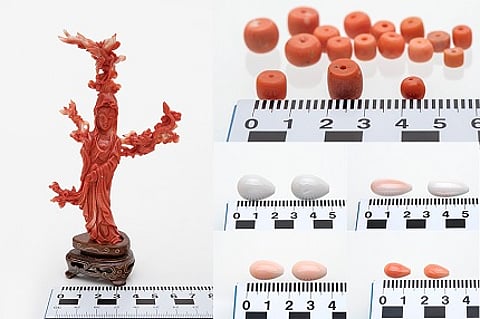

An international research group led by scientists from the Swiss Gemmological Institute SSEF and the University of Zurich’s Institute of Forensic Medicine (IRM) has reported a breakthrough in precious coral jewellery traceability, through the use of a novel forensically validated genetic technique called Coral-ID. Coral-ID is the first reliable and forensically validated method to scientifically identify corals using quasi non-destructive sampling, so that species protected by the Convention on the International Trade of Endangered Species (CITES) can be distinguished from their non-protected counterparts. Four precious coral species used in the jewellery trade are listed on Appendix III of CITES, and they require species-specific and country-of-origin documentation when being traded and transported across international borders. For the customs authorities that must check the merchandise, the colour of a coral specimen has to date been the main indicator for ascertaining its biological species identity. However, different coral species can have similar colour ranges, and this frequently has caused difficulties when trying to conclusively identify the specific species of coral contained in a jewellery item.
The Coral-ID method was tested on a real-world set of samples, comprised of 20 coral-set items seized between 2009 and 2017 by the Swiss customs authorities, because they lacked valid CITES documentation. Multiple species were found among corals of similar appearance, highlighting the importance of using the new Coral-ID method, which is to avoid misidentification of CITES-listed species as non-CITES listed species, and vice versa. Three of the 20 tested samples were shown to be of species that have not previously been associated with precious coral in the jewellery trade. This further underscores the need for additional scientific research.
Dr. Michael S. Krzemnicki, Director of SSEF said, “The research shows the importance of carrying out fundamental science and peer-reviewed research on raw materials used in the jewellery industry. Genetic analysis of precious corals is clearly a very useful tool to achieve greater transparency in the trade.” Precious coral identification services are being offered by SSEF in partnership with the Institute of Forensic Medicine at the University of Zurich, which is one of Switzerland’s leading forensic institutes. All analyses are carried out in laboratory facilities accredited according to the ISO 17025 standards. Detailed information about the use of DNA fingerprinting of precious corals is published in the leading peer-reviewed journal Forensic Science International: Genetics.
Follow DiamondWorld on Instagram: @diamondworldnet
Follow DiamondWorld on Twitter: @diamondworldnet
Follow DiamondWorld on Facebook: @diamondworldnet
